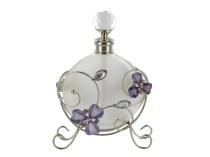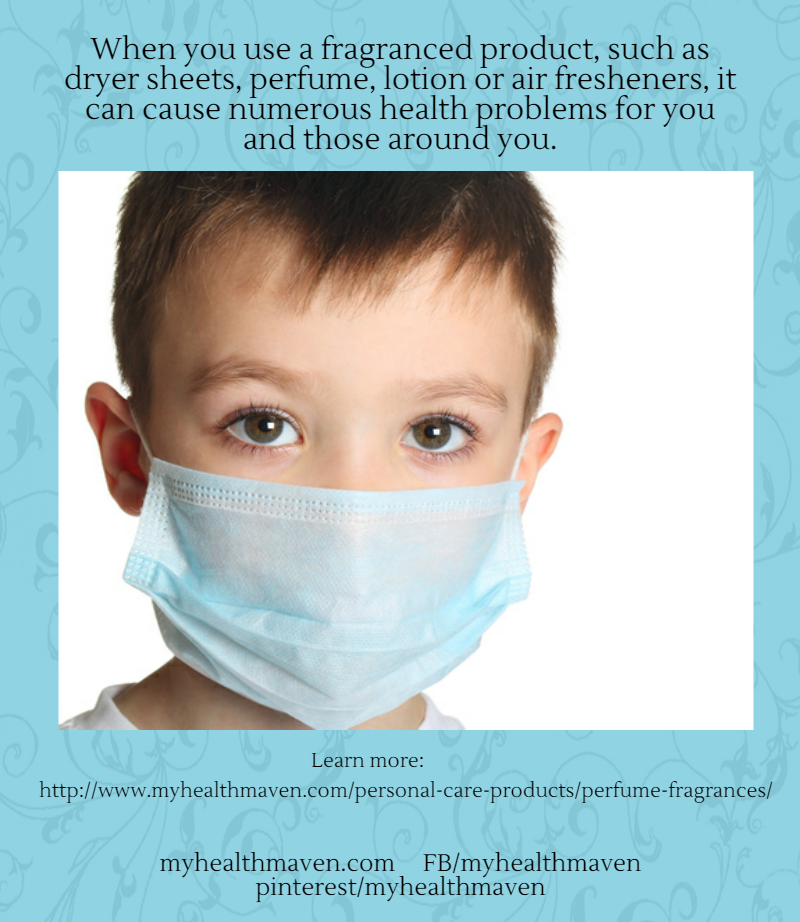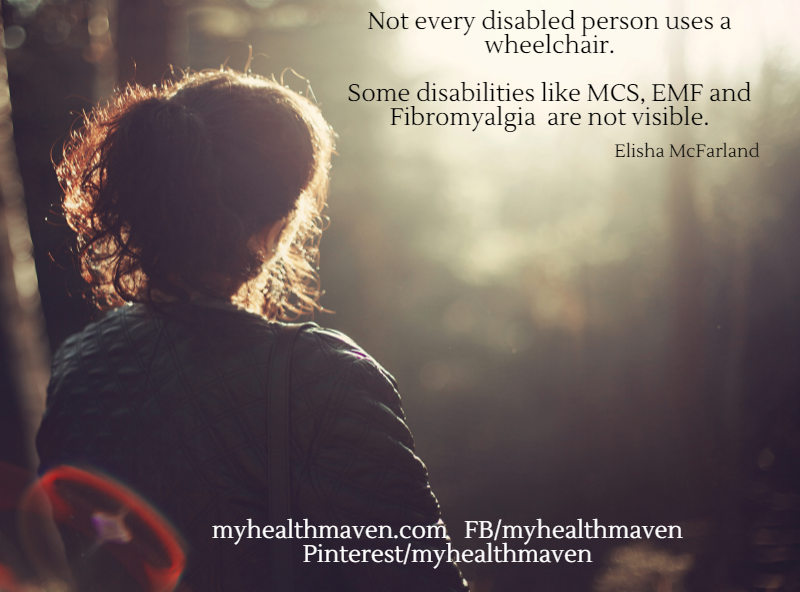
So how many of you have reactions to fragrance and have been told it’s all in your head? I’m guessing quite a few. The truth is it is not in your head, the symptoms are real. In fact, up to one third of all adults live with fragrance sensitivity that can trigger numerous symptoms including skin irritation, headaches trouble breathing, extreme cases can include anaphylactic shock. The American Academy of Dermatology (1) lists fragrance as the leading cause of contact dermatitis. (2) The symptoms of contact dermatitis can range from itching, redness, burning skin or blisters on the affected area.
So, What Is Fragrance Sensitivity?
In basic terms it is a negative reaction to any product with fragrance. There are literally thousands of different fragrances used in modern products. Fragrance is not limited to cosmetics and perfumes. Unfortunately, fragrance is in just about everything, ranging from scented trash bags, to baby wipes, toothpaste, topical medications and more.
People with fragrance sensitivities frequently react to the following products:
Air fresheners
Perfume
Body spray/Cologne
Dryer Sheets
Fabric Softeners
Laundry Detergent
Cleaning Products
Body Lotions
Hair Products (shampoo, conditioner, hairspray, mousse etc)
Deodorants/Antiperspirants
Essential Oils
Pesticides
Herbicides

What Causes Fragrance Sensitivity?
There can be many factors including genetic predisposition, body toxin overload, allergies or other causes.
Many people are simply unaware that “fragrance” in modern products means a mixture of synthetic chemicals…anywhere from a handful of chemicals per product to hundreds. These fragranced products outgas a variety of VOC’s that are breathed in, and are also absorbed by the skin…the body’s largest organ of absorption and elimination. Certain products also contain chemicals that are known to be hazardous to your health, such as acetaldehyde and formaldehyde.
A Few Scary Facts
-The perfume industry is not regulated by any governmental agency. Fragrance formulas are considered “trade secrets” therefore their ingredients are not required to be labelled on the product.
-There are 3,000-5,000 chemicals used in fragrances.
-95% of these chemicals are derived from petroleum.
-Over 80% of these chemicals HAVE NOT been tested for human toxicity
-Some of these chemicals are on the EPA hazardous waste list
If a product uses a masking fragrance, you may not be aware that you had an exposure until it is too late.
According to Joe Schwarez Ph.D “Unscented products are formulated to have no smell but can contain ingredients that have a smell, but the smell has been neutralized by other components.
A fragrance-free product cannot contain any ingredients that have been added to impart a smell but may contain ingredients that have a scent but are not added because of their scent. For example, if a cream is made with an oil that has a smell, it could still be labeled as fragrance-free because the purpose of the oil is to act as an emollient, not as a scent. But it could not be labeled unscented. However, if a product is formulated with lavender, for example, but some chemical is added to mask the smell, the product can be labeled as “unscented.”
So, what does all that mean? Read labels and test products to determine their safety for you!
What to Do if You Are Fragrance Sensitive
Most importantly, read the labels of all of the products you have in your home. This should include personal care products, soaps, shampoos, body spray, detergents etc., as well as cleaning products and even candles. You need to remove all scented products, especially those that are made with synthetic chemicals.
While this may seem challenging, it is a critical component for your health, as well as the health of everyone who lives in the home, including pets. Many products are not clearly labelled. Many products that are labelled as unscented, actually have a masking fragrance added to remove “scents”.

How Common is Fragrance Sensitivity?
A large Australian study (3) published in Preventative Medicine Reports found that one third of participants experienced one or more health problems after exposure to scented products. Some had extreme reactions that included difficulty breathing and struggles with performing daily tasks.
The study also including these stats:
17% of participants reported experiencing respiratory difficulties due to certain fragrances, while 14% reported congestion and watery eyes.
About 10% experienced migraines and skin problems.
About 8% reported asthma attacks, and the same number said they missed work due to symptoms caused by fragrance exposure in the workplace.
Between 3% and 5% reported gastrointestinal problems, cognitive or neurological symptoms (dizziness or fainting, trouble concentrating, etc.).
Additional research (4)studies have found that between 17% and 20% of the general U.S. population has reported breathing difficulties, headaches or other health problems when exposed to air fresheners and deodorizers.
When participants in one study were asked about their preferences related to fragrances/scents in indoor environments, here’s how they responded:
42.8% would be supportive of a fragrance-free policy in the workplace.
43.2% would prefer that health care facilities and health care professionals be fragrance-free.
57.7% would prefer flying on an airplane without scented air pumped through the passenger cabin.
55.6% would prefer staying in a hotel without fragranced air.
Symptoms of Fragrance Sensitivity
After going to a public place, a store, someone’s house, or even walking outside have you experienced any of the following?
*Headaches
*Dizziness
*Brain fog (inability to think clearly)
*Slurred speech
*Burning /tingling around the mouth
*Itchy/ burning skin
*Swollen face or hands
*Respiratory Symptoms
*Coughing
* Have you been enjoying a walk in the neighborhood and found you have suddenly fallen without realizing why?
* Do you get a numb feeling on the side of your face—and the doctors can’t find the reason?
*Fabric softeners, like other fragrant products, contain petrochemicals, used in untested combination. These chemicals can adversely affect the central nervous system (CNS)—your brain and spine.
* CNS exposure symptoms include: aphasia, blurred vision, disorientation, dizziness, headaches, hunger memory loss, numbness in face, pain in neck and spine.
If you have experienced these symptoms, you may consider keeping a journal about what you do on a daily basis. Document where you have been and what you have eaten and note any symptoms. Over time you may notice patterns. Perhaps after a meeting, you feel unusually tired, or that it’s hard to concentrate. You may observe that after going down the detergent aisle at the store you have a headache. These are important clues to note and discuss with your healthcare practitioner.

12 Step Action Plan
If you are living with a fragrance or chemical sensitivity or MCS it is easy to feel overwhelmed, but there are many proactive steps you can take to improve your living environment and your health. Some basic steps include:
- Clean Up at Home-Remove all scented products and all conventional cleaning products, they generally contain fragrances and chemicals that are harmful to the respiratory system and your overall health. Most cleaning products can be replaced with baking soda, water and vinegar. Check this link for nontoxic cleaning recipes. (5)
- No Air Fresheners or Dryer Sheets-These are full of cancer-causing chemicals and should never be used. Check this link for making your own air fresheners. (6)
- Drink pure filtered water. Many options are available such as whole house water filters, reverse osmosis, countertop models and carbon filter pitchers. A healthy amount of water would be half your weight in ounces. So, if you weigh 150 pounds, your body needs 75 ounces of water daily.
- Purchase an air cleaner for your home. Many companies produce portable air filters that can be rolled from room to room, as well as whole house air filters.
- Eat organic food as often as possible. If you can grow your own foods, you will receive the benefit of truly fresh food, without pesticides or herbicides as well as enjoying all the health benefits of working outside in the fresh air, and sunshine. If you can’t have a garden, purchase produce locally from the farmer’s market or organic market.
- Use safe laundry products. There are many chemical free and fragrance-free options available such as Soap Nuts, or T-wave capsules which are reusable and require no detergent to get your clothes clean. The purchase also includes a bottle of liquid enzymes to help remove stubborn stains. For laundry hints click here. (7)
- Use organic body care products. Don’t trust a product without reading the label. If you can’t pronounce the ingredients on the label, you probably shouldn’t be using it. There are many websites to look up ingredients such as www.cosmeticsdatabase.org or books such as “A Consumer’s Dictionary of Cosmetic Ingredients”.
- Shower and change your clothes after going out. Upon arriving home, wash your clothes, shower and change. This will prevent the chemicals that are on your clothes and body from out gassing into your home, as well as being continually absorbed through your skin during the day.
- Wear organic clothes. Cotton is one of the most heavily sprayed crops. If you wear cotton, make sure it’s organic. Look for other natural fiber clothes made from bamboo or hemp. Learn more about toxins in clothes. (8)
- Wear a mask. Whenever you go out wear a mask to protect yourself from inhaling chemicals from products other people may use, as well as products in the store, and general outdoor pollutants. It will not eliminate everything, but will greatly reduce your exposure risk.
- Follow a detox protocol. Find a health care practitioner familiar with MCS to oversee your protocol. The biggest mistake people make is in detoxing too fast. If you detox too fast, your symptoms can worsen and you can become ill as your body dumps chemicals faster than your liver can process them. Detox baths and infrared saunas are a wonderful option, under your practitioner’s supervision.
- Eat more fiber. Consider adding a fiber drink or supplement to your daily routine. Most of us are not consuming the 35 grams of fiber daily that is recommended. Fiber helps to keep things moving along. The longer your exit time for food, the greater the risk of food putrefaction in your intestines, as the undigested backed up waste is absorbed into the bloodstream which causes auto-intoxication.
In Conclusion
The incidence of fragrance/chemical sensitivity and MCS (Multiple Chemical Sensitivity) is growing, it is easy to correlate it to the increased number of chemicals used in our daily lives. It is also an illness that requires time, patience and persistence to recover from.
Genetic testing and lab work may give insight into the root cause of your symptoms / illness and will help you and your practitioner determine a protocol that works for you.
Keeping a daily journal of your diet, routine, exposures and reactions will provide vital insight to you and your practitioner.
Educate yourself about the products you are using and look for healthier, non-toxic options whenever possible.
Eliminate your exposure to toxins by switching to safe cleaning and personal care products. Avoid the use of toxic chemicals in your yard and home.
Learn more about MCS
References:
1. Itchy rash could be contact dermatitis. American Academy of Dermatology. (n.d.). Retrieved March 11, 2023, from https://www.aad.org/public/everyday-care/itchy-skin/rash/itchy-rash-contact-dermatitis
2. Larsen, W. G. (n.d.). Perfume dermatitis. Retrieved March 11, 2023, from https://www.jaad.org/article/S0190-9622(85)70001-1/fulltext
3. Steinemann, A. (2016, November 14). Health and societal effects from exposure to fragranced consumer products. Preventive medicine reports. Retrieved March 11, 2023, from https://www.ncbi.nlm.nih.gov/pmc/articles/PMC5122698/
4. Caress, S. M., & Steinemann, A. C. (2009). Prevalence of Fragrance Sensitivity in the American Population. Journal of Environmental Health, 71(7), 46–50. http://www.jstor.org/stable/26327879
5. McFarland, E. (n.d.) (2018, March 1). 10 Simple Ways to Reduce Toxins in the Home. My Health Maven – Improving Health through Education. Retrieved March 11, 2023, from https://myhealthmaven.com/10-simple-ways-reduce-toxins-home/
6. McFarland, E. (n.d.). Make Your Own Non Toxic Air Fresheners. My Health Maven – Improving Health through Education. Retrieved March 11, 2023, from https://myhealthmaven.com/?s=Make%2BYour%2BOwn%2BNon%2BToxic%2BAir%2BFreshener%2BWith%2BEssential%2BOils
7. McFarland, E. (2016, December 20). Laundry Soap Options. My Health Maven – Improving Health through Education. Retrieved March 11, 2023, from https://myhealthmaven.com/laundry-soap-options/
8. McFarland, E. (2016, December 7). Are Your Clothes Making You Sick? My Health Maven – Improving Health through Education. Retrieved March 11, 2023, from https://myhealthmaven.com/clothes-making-sick/







